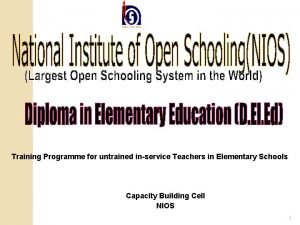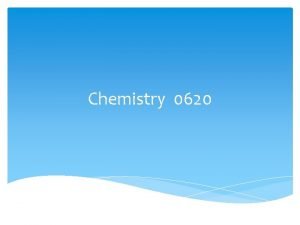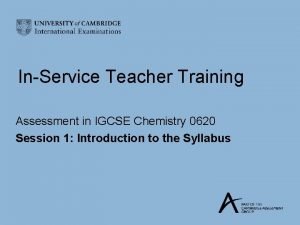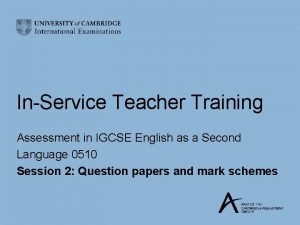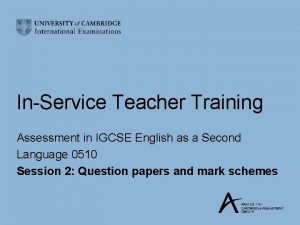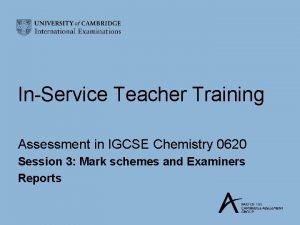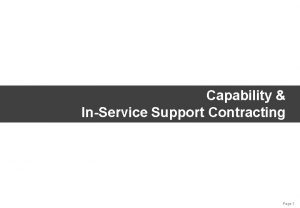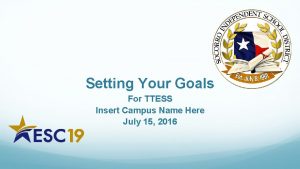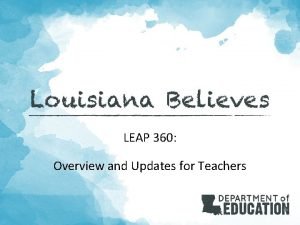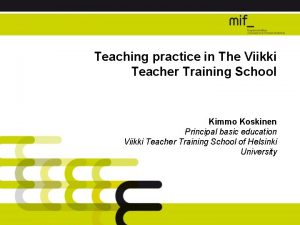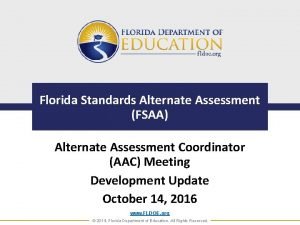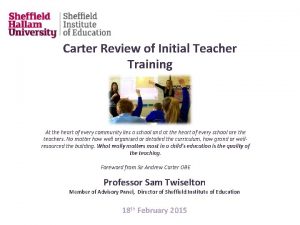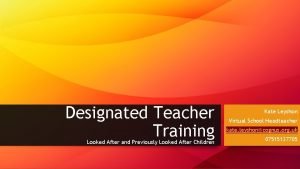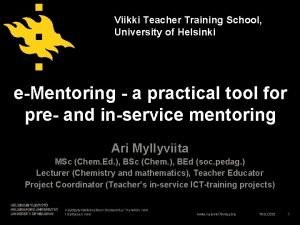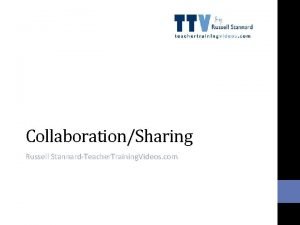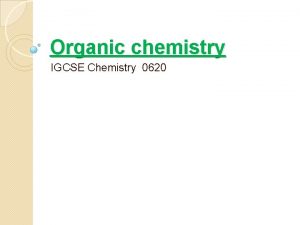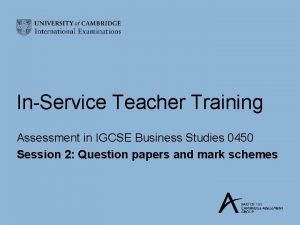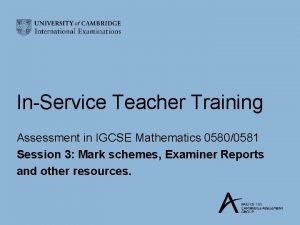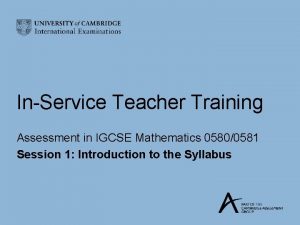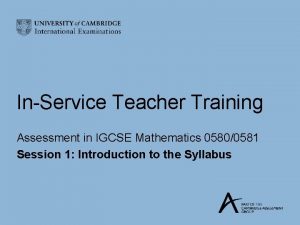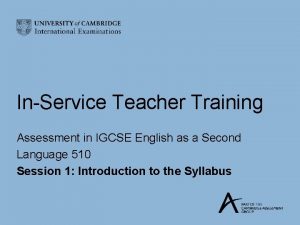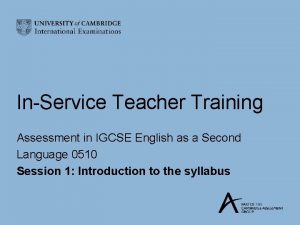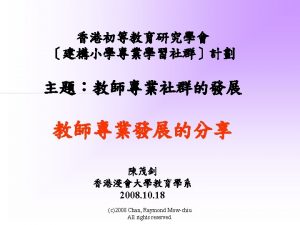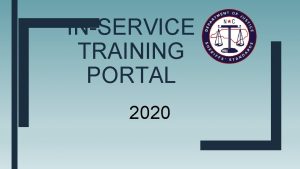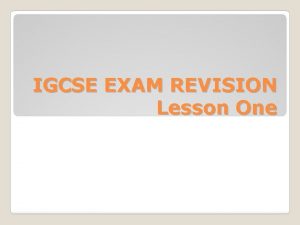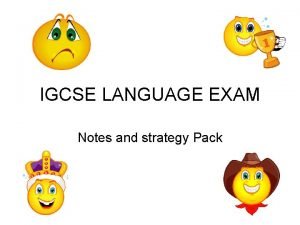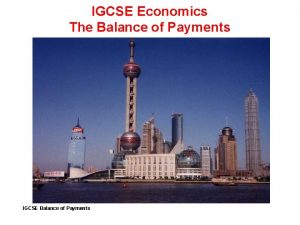InService Teacher Training Assessment in IGCSE Chemistry 0620























- Slides: 23

In-Service Teacher Training Assessment in IGCSE Chemistry 0620 Session 1: Introduction to the Syllabus

www. cie. org. uk Welcome • Introductions • Background • Aim of training

www. cie. org. uk Session 1 looks at: • Syllabus aims • The structure of the syllabus • Assessment objectives • The development of different skills • The difference between formative and summative assessment

www. cie. org. uk Aims of the syllabus (1): Relevance and application • Relevance of chemistry to everyday life • The social and economic aspects of chemistry • The application of chemistry in solving problems • Ethical and cultural influences

www. cie. org. uk Aims of the syllabus (2): Practical skills • • Carrying out experiments Inventiveness Following instructions Accuracy and precision

www. cie. org. uk Aims of the syllabus (3): Communication and objectivity • Communication skills are important in everyday life • Objectivity is an important part of science • Science has some limitations and does not always provide answers

www. cie. org. uk Structure of the syllabus (1): Overall structure • There are 14 sections covering physical, inorganic and organic chemistry • Some sections are divided into subsections

www. cie. org. uk Structure of the syllabus (2): Overall structure • The Core curriculum is applicable to all students • The Extended curriculum builds on the core material and the relevant sections are placed next to each other

www. cie. org. uk Structure of the syllabus (3): Overview of curriculum content • • 1 Particles (C + S)) 2 Experimental techniques (C + S)) 3 Atomic structure and bonding (C + S) 4 Stoichiometry (formulae and equations) (C+ S) • 5 Electricity and chemistry (C + S) • 6 Chemical changes (energetics) (C + S) • 7 Chemical reactions (rates and equilibrium) (C + S)

www. cie. org. uk Structure of the syllabus (4): Overview of curriculum content (2) • • 8 Acids, bases and salts (C + S) 9 The periodic table (C + S) 10 Metals (reactivity, metal extraction) (C+S) 11 Air and water (including gaseous pollutants) (C + S) • 12 Sulphur (S) • 13 Carbonates (C) • 14 Organic chemistry (alkanes, alkenes, alcohols, acids & macromolecules) (C + S)

www. cie. org. uk Structure of the syllabus (5): Core and Supplement • What extra knowledge is required for the Supplement? • What extra skills are required for the Supplement? • Are there any parts of the Supplement and Core which overlap? • Do certain topics appear in more than one of the sections 1 -14?

www. cie. org. uk Assessment objectives (1): General assessment objectives Assessment objective Weighting • Knowledge with understanding 50% • Handling information and problem solving 30% • Experimental skills 20%

www. cie. org. uk Assessment objectives (2): The scheme of assessment Paper • Paper 1 (multiple choice) • Paper 2 (theory) Weighting 30% Discriminating Core or grades Extension C-G C 50% 20% A-D * C + E (theory) C OR • Paper 3 • Papers 4 or 5 or 6 (practical)

www. cie. org. uk Assessment objectives (3): Paper 2 or Paper 3? • Paper 2 is based on the Core curriculum (80 marks) Ø Paper 2 targets C-G candidates • Paper 3 is based on the Extended curriculum (60 marks) plus 20 marks targeted at the Core curriculum Ø Paper 3 targets A-C candidates • Which paper should be chosen?

www. cie. org. uk Assessment objectives (4): Practical assessment • Paper 4 Coursework • Paper 5 Practical Test • Paper 6 Alternative to Practical

www. cie. org. uk Assessment objectives (5): The importance of practical work Candidates need to be able to: • Understand how to carry out practical procedures • Record readings and construct tables of data

www. cie. org. uk Assessment objectives (6): The importance of practical work Candidates need to be able to: • Undertake tests for gases and ions • Identify sources of error • Suggest suitable techniques and apparatus for an investigation

www. cie. org. uk Assessment objectives (7): Coursework (Paper 4) • There are 4 strands: • C 1 Using and organizing techniques, apparatus and materials • C 2 Observing, measuring and recording • C 3 Handling experimental observations and data • C 4 Planning investigations

www. cie. org. uk Assessment objectives (8): The role of teachers in practical work • Provide students with opportunities to develop their practical skills • Produce and assist with subjects for investigations • Sources of information • Advise students in the practicality of schemes they have chosen • Suggest length of time and general treatment of the problem • Exercise continuing supervision of the assessment

www. cie. org. uk Formative assessment (1): Formative and summative assessment • Summative assessment involves terminal testing and interim testing • There is no individual feedback on summative assessments that involve public examinations • Formative assessment involves assessing student progress on a regular basis • There is always feedback to the student in formative assessment • The feedback from formative assessments are used by the students to improve their performance

www. cie. org. uk Formative assessment (2): The nature of formative assessment • Formative assessment involves an interaction between the student and teacher • The teacher is able to assess progress, for example by feedback on tests etc. • True formative assessment encourages improvement in performance

www. cie. org. uk Formative assessment (3): Ways of assessing progress • • • Marking Feedback on tests Answers given to verbal questions Target setting Student self evaluation

Closing comments
 Inservice training assignment
Inservice training assignment Igcse chemistry syllabus
Igcse chemistry syllabus Nature of formative assessment
Nature of formative assessment Igcse teacher training
Igcse teacher training Igcse teacher training
Igcse teacher training Cie past papers chemistry
Cie past papers chemistry Inservice
Inservice Inservice examples
Inservice examples Quantitative chemistry igcse
Quantitative chemistry igcse Erf promotion
Erf promotion Good afternoon student
Good afternoon student Ib chemistry organic chemistry
Ib chemistry organic chemistry Inorganic vs organic chemistry
Inorganic vs organic chemistry T tess professional goal examples
T tess professional goal examples Leap 360 geometry interim test form 2 answer key
Leap 360 geometry interim test form 2 answer key Viikki teacher training school
Viikki teacher training school Fsaa training modules
Fsaa training modules Elf montessori
Elf montessori Carter review of initial teacher training
Carter review of initial teacher training Designated teacher training
Designated teacher training Vbs teacher training
Vbs teacher training Viikki teacher training school
Viikki teacher training school Russell stannard teacher training videos
Russell stannard teacher training videos Chapter 11 assessment chemistry
Chapter 11 assessment chemistry
